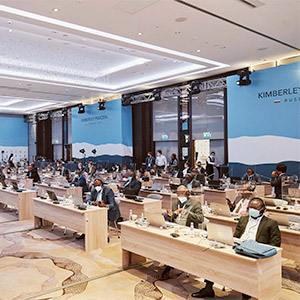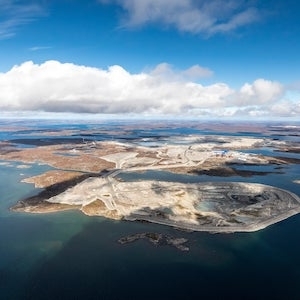
Despite U.S. sanctions, Russian diamond sales rose after the Ukraine war began, according to Kimberley Process (KP) statistics for the first half of 2022.
The numbers—which have not yet been made public—reveal that following the Feb. 24, 2022, invasion of Ukraine, Russia sharply increased diamond exports to the European Union (which includes Antwerp, Belgium) as well as to two allies, Armenia and Belarus. Exports to other countries dropped—and in some cases, like the United States, they ceased entirely.
In the second quarter of 2022 (April through June), Russian rough diamond exports were $1.11 billion, compared with $1.01 billion in the first quarter of 2022, and $1.09 billion in the second quarter of 2021. Those totals include both gem and industrial diamonds.
No data was available for the third and fourth quarters of 2022, though preliminary third-quarter numbers also show an increase, says a source.
Russia’s gains were all in value, rather than volume. The country exported significantly fewer carats in the second quarter of 2022 (9.4 million) than it did in the second quarter of 2021 (11.9 million). Yet the average per-carat price of those exports rose, to $119 in 2022’s second quarter from $91 during the same period of 2021, the stats say.
Diamond analyst Edahn Golan believes this could reflect more selective sales: “Instead of selling goods by the parcel, they are just selling the goods people need.”
He notes that Russia’s increases were far smaller than other producers’: De Beers’ sales in the first half of 2022 rose 24% from the prior year, and its average per-carat price climbed 58%.
Still, the statistics show that “the United States didn’t end the demand for Russian goods,” says Golan. “The money’s just being rerouted.”
That is demonstrated in the KP data. The largest destination for Russian exports in the second quarter of 2022 was the European Union, which received $669.5 million in goods, up from $439 million in the first quarter. The vast majority of them were likely shipped to Antwerp.
Also in the second quarter of 2022, Russian diamond exports to Armenia swelled to $6.9 million; they’d totaled $20,740 in the first quarter. Exports to Belarus, another Russian ally, totaled $2.8 million in the first quarter, then reached $12.4 million in the second.
“That’s very odd,” says Golan. “There’s not a lot of manufacturing going on in Belarus, though there’s some in Armenia. Belarus seems like a transit point.”
Second-quarter diamond export destinations also included the United Arab Emirates, which imported $241.6 million in Russian rough; India, which took in $182.4 million; and China, $1.2 million. All those numbers represent declines from the first quarter.
Other markets closed their doors. In the first quarter of 2022, Russia sent the United States $7.8 million in rough. In the second quarter of 2022, that number dropped to zero. (U.S. sanctions, enacted shortly after the invasion, bar U.S. companies from dealing directly with Russian diamond sellers.)
There also were no direct Russian diamond exports to Israel, Singapore, and Switzerland in the second quarter. All three received exports in the first.
The statistics note a slight increase in Russian diamond production in the first half of 2022. During that period, the country produced 20.3 million carats, valued at $1.7 billion. In the first half of 2021, it produced 20.1 million carats, valued at $1.3 billion.
Diamond analyst Paul Zimnisky cautions that KP figures are not always reliable, though he adds he’d rather have them than not.
Overall, the numbers are “not a good sign for the international jewelry industry’s reputation and the greater cause of democracy in Ukraine,” says Sara Yood, deputy general counsel of the Jewelers Vigilance Committee.
“I’m glad to see some direct reflection of the impact of the U.S. ban, but it just looks like those carats were sent elsewhere, including a significant bump to the European Union. If I were the United States and European Union looking at this data, I would be very concerned and even more motivated to work on closing the substantial transformation workaround pipeline that is allowing Russian Federation diamonds to enter the U.S. market.”
Top: The Kimberley Process plenary held in Moscow in November 2021. (Photo courtesy of the Kimberley Process)
- Subscribe to the JCK News Daily
- Subscribe to the JCK Special Report
- Follow JCK on Instagram: @jckmagazine
- Follow JCK on X: @jckmagazine
- Follow JCK on Facebook: @jckmagazine






